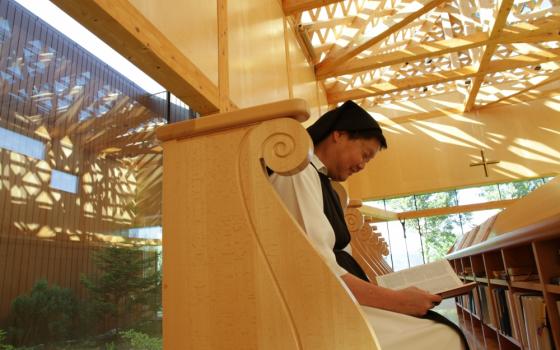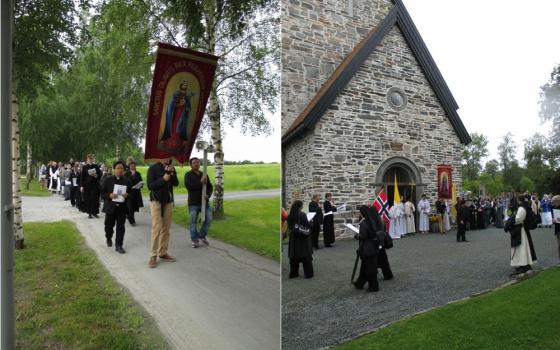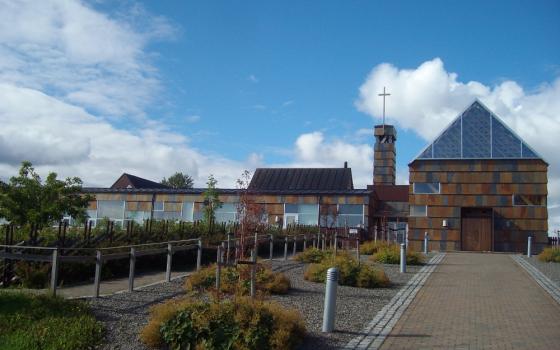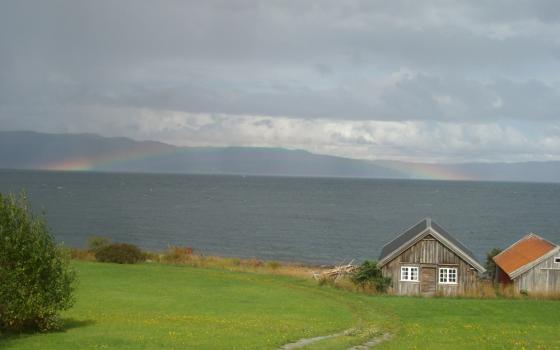“Pray for us, holy Olav, Norway’s eternal king!” The regal notes of the refrain rang out like a jubilant trumpet as Catholics from the Trondheim and Oslo dioceses, joined by pilgrims from France, Germany, Poland, the United States and other countries, processed to Stiklestad church which houses the stone on which St. Olav was killed in 1030. Also, each year more and more pilgrims walk the trails to Nidaros Cathedral, which has been one of the three main pilgrimage sites (besides Santiago de Compostela and Jerusalem) since the Middle Ages.
St. Olav is credited with Christianizing Norway. For us Catholics, it is almost amusing to see the Norwegian (Lutheran) church embracing St. Olav as a national figure. Nidaros Cathedral was, of course, Catholic until the Reformation. Now it is the See of the Lutheran bishop of Nidaros.
Although the Reformation in Norway was much more gradual and much less bloody than in England, the last Catholic archbishop, Olav Engelbrektsson, was forced into exile in 1537, and the country became Lutheran. Monks were not permitted to enter Norway until 1897, and Jesuits were not allowed into the country until 1956. It wasn’t until the 1990s that there was a “boom” of religious orders in Norway: Cistercians, Brigittines, Carmelites, Poor Clares, Missionary Servants of the Holy Trinity, Sisters of the Holy Cross, and Missionaries of Charity joined Dominicans, Augustinians, and Picpus Fathers who were already there.
Our own monastery traces its beginning to this time. In 1992, a Norwegian nun from France received permission to return to Norway to see if the climate was right for Cistercian life. She set up a temporary monastery and was given a sister from Our Lady of the Mississippi Abbey (Dubuque, Iowa) to help her. For 18 months they lived on the island of Tautra near the ruins of a Cistercian men’s monastery which had been closed in 1531. Then she got seriously ill and had to return to France. Meanwhile, Mississippi Abbey had been blessed with vocations and had to decide whether to enlarge their own monastery or found a new one. They were invited by the bishop of Trondheim who keenly wanted contemplatives in the diocese, and after a lengthy discernment, the nuns voted unanimously to make a foundation in Norway. In February 1999, Abbess Gail Fitzpatrick sent five nuns, the Norwegian from France, and a Norwegian nun from Wrentham to Tautra.
Ecumenical relations really opened up with John Paul II’s visit to Nidaros Cathedral in 1989. Catholics were allowed to celebrate Catholic Mass on the Feast of St. Olav, July 29, in Nidaros Cathedral at 8 in the morning. For many Catholics, this meant a several-hours journey in the wee hours in order to attend. In recent years the Mass has been celebrated at 2:30 in the afternoon, and many more have been able to celebrate this high point in the Norwegian liturgical year. Our relationship with the Church of Norway is excellent, and we have been allowed to use Nidaros Cathedral also for several important occasions, like the celebration of the canonization of John Paul II and the first ordination of a Catholic priest in that cathedral since the Reformation.
Like England, Norway has a constitutional monarch. (Kong Harald V is a great-great- grandson of Queen Victoria.) The Church of Norway has been Lutheran since the Reformation, but in 2013 there was separation of church and state. The country has been Christian since the 11th century, much longer than the U.S. Though many would characterize today’s Norway as secular and post-Christian, the country’s Christian history has imbued even secular society with the church calendar in ways incomprehensible to Americans. A secular newspaper could announce that a new hotel will be opened in time for Pentecost. Most Americans don’t know what Pentecost is or when it is celebrated. The school year ends on the last Friday before the Feast of John the Baptist (June 24).
Perhaps the most startling juxtaposition for us is the secularization of the word “confirmation.” Ninth-graders can choose between “church confirmation” and “civil confirmation.” It has become more of a coming-of-age ceremony than a sacrament, but obviously has its roots in Catholic practice of ages past. Society took the word “confirmation” because it meant becoming an adult.
In our region, Nord-Trøndelag, the people’s spirituality seems to have retained a Catholic flavor. There are ruins of a medieval Cistercian monastery on our island, and we were welcomed in 1999 with a warmth far beyond our expectations. There is a sense that the Cistercians belong on Tautra, and townspeople speak of us as “our nuns.”
In 2006, when we moved into the newly built permanent monastery, we had open house on the weekends in September. In those nine days, 7,000 people came through the monastery. We were astounded that there was so much interest in a little group of Cistercian nuns. While there were some incidents when curiosity seemed to be the main motivation — I hardly dared come down the driveway to check our mailbox because of the number of tourists with cameras waiting for a “nun sighting” — it must have been more than mere curiosity or interest in the architecture. Some took the self-guided tour, which began in the church and ended in the soap production room, and then began the tour again. This time they just sat quietly in the church, and some of them wept. Our view of the fjord through plate-glass windows right behind the altar touches the Norwegian soul, so closely connected to God’s creation in the natural beauty which surrounds us.
Recently one of the former mayors of Frosta lost his wife to acute leukemia. Two of us attended the funeral, and the next day, in the midst of their grief, the former mayor and six members of his family came to vespers in our church. People have come to know that we have an open church, that the nuns are here, always, and that we pray seven times a day for them and the needs of our world, and live in a manner that is closely connected to life, death and eternity.
When we came here 16 years ago, we were determined to be a Cistercian presence and witness to the monastic life centered on the worship of God, whether or not we would receive vocations. We simply didn’t know if that would be possible in a Lutheran land. In fact, we had only one native Norwegian enter our community; one of the foundresses is a Norwegian. But God has blessed our big adventure on this little island, and from seven foundresses, we now number 12 in the house, three of them in the novitiate — from England, Poland and Belgium.
This morning a display of the aurora borealis was a sign of God’s light and love which embraces the whole world in ever changing and beautiful ways. We just have to be awake, and looking into the darkness to see it.
[Sr. Sheryl Frances Chen was assistant editor of U.S. Catholic magazine before she entered the monastery to join the Order of Cistercians of the Strict Observance (OCSO). Now she is chantress and Saturday cook at Tautra Mariakloster on an island in the Trondheim fjord.]




